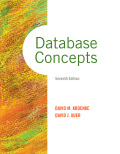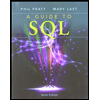
Concept explainers
A.
Explanation of Solution
“Yes”, SQL server supports both locking such as optimistic and pessimistic.
Reason:
The SQL server supports the optimistic and pessimistic locks.
Optimistic lock:
- Multiple users can update the data and it gets lock after the transaction has been processed in optimistic lock. It can be used for web applications.
- There is no conflict occur during transaction. If conflict occurs then it can be repeated until no conflict.
- There is no need to lock the
database resources and it prevents database from deadlocks. - The disadvantage is that it allows the applications from selecting and modifying the same data...
B.
Explanation of Solution
Transaction Isolation Level:
The transaction isolation level gives the measure of the extent to which transaction isolation succeeds.
- This process is defined by the presence or the absence of the phenomena such as dirty read, nonrepeatable reads, and phantom read.
- These problems occur when we read data from the database.
There are four levels of transactions. They are,
- Read uncommitted isolation level
- Read committed isolation level
- Repeatable reads isolation level
- Serializable isolation level
Read uncommitted isolation level:
Read uncommitted isolation level is the lowest isolation level which allows dirty reads, nonrepeatable reads, and phantom reads.
- It makes the transaction to read any data currently on a data page irrespective of the data has been committed.
- The uncommitted read isolation level applies to read-only operations like SELECT, SELECT INTO, and FETCH.
- The uncommitted read should not be applied for the cases where the answer must be accurate.
- The uncommitted read does affect other transactions.
Read committed Isolation level:
Read committed Isolation level allows nonrepeatable reads and phantom reads but it prevents dirty read...
C.
Explanation of Solution
Cursor:
The term cursor is used to retrieve the information in row by row manner. If the records stored in the database table, which needs to be updated one row at a time is carried over by cursor.
- It plays the major role for fetching a required row from the table in the database which holds numerous records.
- Cursors are defined using SELECT statement.
- It points the set of rows which is resulted from an SQL SELECT statement.
- In general the cursor is placed in the first or last row.
- It influences the performance of the SQL Server as it uses the SQL server instances memory, decrease network bandwidth, and reduction in concurrency.
- It’s recommended to avoid the use of cursor and the cursor can be replaced with WHILE loop, temporary tables, and sub queries.
- The types of cursor are listed below:
- Forward-only cursor
- Static cursor
- Dynamic cursor
- Keyset cursor
Forward-only cursor:
Forward-only cursor is used for fastest retrieval of data from the database. It is the fastest cursor among all the cursors but with the drawback it does not support backward scrolling.
- Data deletion, updating the data can be done using the Forward-Only cursor.
- It is sensitive as any changes made in the database will affect the original data source...
D.
Explanation of Solution
Difference between Security model for SQL server and figure 6-16:
Note: Refer Figure 6-16 in textbook: “A model of DBMS security”
| Security model for SQL server | Security model for database Management system |
| It provides the security architecture to permit the database developer to make secure database application and counter threats. |
It provides the |
| It contains the hierarchical set of entities with server. Each and every server contains multiple databases, and each and every database contains set of securable objects... |
E.
Explanation of Solution
Types of SQL server backup:
There are different types of SQL server backups. They are,
- Full backup
- Differential backup
- Transaction log backup
- Database file and Filegroup backups
Full backup:
The full backup in SQL server is simple type of backup which does not depends on recovery model.
- It backs up the any type of activity during the backup.
- It backs up any type of uncommitted transactions in transaction log file.
Differential backup:
The differential backup helps to reduce the time for restoring the modified database.
- It backs up the portion of database that have modified since final full database backup.
- It backs up any type of activity during differential backup and also any type of uncommitted transactions in transaction log file...
F.
Explanation of Solution
SQL server recovery models:
There are three different types of recovery models in SQL server. They are,
- Simple
- Full
- Bulk-logged
Simple:
Simple recovery model helps to maintains smallest quantity of information in transaction log.
- Simple recovery model restores the data from full or differential backups. It requires less administration power and easy to manage than full or bulk-logged model.
- It expense high data loss when data file damages occurs.
- The benefits allows the high-performance copy operation.
- The drawback of the simple model is changes because database or differential backup must need to be rebuild...
Want to see the full answer?
Check out a sample textbook solution
Chapter 6 Solutions
EBK DATABASE CONCEPTS
- Consider the following relational schema. An employee can work in more than one department; the pct_time field of the Works relation shows the percentage of time that a given employee works in a given department. Emp(eid: integer, ename: string, age: integer, salary: real) Works(eid: integer, did: integer, pct_time: integer) Dept(did: integer, budget: real, managerid: integer) Write the following queries in SQL: a. Print the name of each employee whose salary exceeds the budget of all of the departments that he or she works in. b. Find the enames of managers who manage only departments with budgets larger than $1 million, but at least one department with budget less than $5 million.arrow_forwardConsider the following schema: Suppliers(sid: integer, sname: string, address: string) Parts(pid: integer, pname: string, color: string) Catalog(sid: integer, pid: integer, cost: real) The Catalog relation lists the prices charged for parts by suppliers. Write the following queries in SQL: a. Find the sids of suppliers who charge more for some part than the average cost of that part (averaged over all the suppliers who supply that part). b. Find the sids of suppliers who supply a red part or a green part. c. For every supplier that supplies a green part and a red part, print the name and price of the most expensive part that she supplies.arrow_forwardThe following relations keep track of airline flight information: Flights(flno: integer, from: string, to: string, distance: integer, departs: time, arrives: time, price: integer) Aircraft(aid: integer, aname: string, cruisingrange: integer) Certified(eid: integer, aid: integer) Employees(eid: integer, ename: string, salary: integer) Note that the Employees relation describes pilots and other kinds of employees as well; every pilot is certified for some aircraft, and only pilots are certified to fly. Write each of the following queries in SQL.(Additional queries using the same schema are listed in the exercises for Chapter 4) a. Identify the routes that can be piloted by every pilot who makes more than $100,000. b. Print the name and salary of every nonpilot whose salary is more than the average salary for pilots. c. Print the names of employees who are certified only on aircrafts with cruising range longer than 1000 miles and who are certified on some Boeing…arrow_forward
- Need help making python code for this!arrow_forward2.7 LAB: Smallest of two numbers Instructor note: Note: this section of your textbook contains activities that you will complete for points. To ensure your work is scored, please access this page from the assignment link provided in the CTU Virtual Campus. If you did not access this page via the CTU Virtual Campus, please do so now.arrow_forwardI help understanding this question d'y + 4dy +3y = a, Initial Conditions: y(0) = 5 & y'(0)=0 Where a = 10 a) Find y(t) =yh(t) +yp(t) in time domainIs the system over-damped, under-damped, or critical? b) Find y(t) using Laplace Transformsarrow_forward
- Given f(t)=a sin(ßt) a = 10 & ß = 23 Find the Laplace Transform using the definition F(s) = ∫f(t)e-stdtarrow_forwardPlease do not use any AI tools to solve this question. I need a fully manual, step-by-step solution with clear explanations, as if it were done by a human tutor. No AI-generated responses, please.arrow_forwardObtain the MUX design for the function F(X,Y,Z) = (0,3,4,7) using an off-the-shelf MUX with an active low strobe input (E).arrow_forward
- I cannot program smart home automation rules from my device using a computer or phone, and I would like to know how to properly connect devices such as switches and sensors together ? Cisco Packet Tracer 1. Smart Home Automation:o Connect a temperature sensor and a fan to a home gateway.o Configure the home gateway so that the fan is activated when the temperature exceedsa set threshold (e.g., 30°C).2. WiFi Network Configuration:o Set up a wireless LAN with a unique SSID.o Enable WPA2 encryption to secure the WiFi network.o Implement MAC address filtering to allow only specific clients to connect.3. WLC Configuration:o Deploy at least two wireless access points connected to a Wireless LAN Controller(WLC).o Configure the WLC to manage the APs, broadcast the configured SSID, and applyconsistent security settings across all APs.arrow_forwardusing r language for integration theta = integral 0 to infinity (x^4)*e^(-x^2)/2 dx (1) use the density function of standard normal distribution N(0,1) f(x) = 1/sqrt(2pi) * e^(-x^2)/2 -infinity <x<infinity as importance function and obtain an estimate theta 1 for theta set m=100 for the estimate whatt is the estimate theta 1? (2)use the density function of gamma (r=5 λ=1/2)distribution f(x)=λ^r/Γ(r) x^(r-1)e^(-λx) x>=0 as importance function and obtain an estimate theta 2 for theta set m=1000 fir the estimate what is the estimate theta2? (3) use simulation (repeat 1000 times) to estimate the variance of the estimates theta1 and theta 2 which one has smaller variance?arrow_forwardusing r language A continuous random variable X has density function f(x)=1/56(3x^2+4x^3+5x^4).0<=x<=2 (1) secify the density g of the random variable Y you find for the acceptance rejection method. (2) what is the value of c you choose to use for the acceptance rejection method (3) use the acceptance rejection method to generate a random sample of size 1000 from the distribution of X .graph the density histogram of the sample and compare it with the density function f(x)arrow_forward
 Database Systems: Design, Implementation, & Manag...Computer ScienceISBN:9781305627482Author:Carlos Coronel, Steven MorrisPublisher:Cengage Learning
Database Systems: Design, Implementation, & Manag...Computer ScienceISBN:9781305627482Author:Carlos Coronel, Steven MorrisPublisher:Cengage Learning Database Systems: Design, Implementation, & Manag...Computer ScienceISBN:9781285196145Author:Steven, Steven Morris, Carlos Coronel, Carlos, Coronel, Carlos; Morris, Carlos Coronel and Steven Morris, Carlos Coronel; Steven Morris, Steven Morris; Carlos CoronelPublisher:Cengage Learning
Database Systems: Design, Implementation, & Manag...Computer ScienceISBN:9781285196145Author:Steven, Steven Morris, Carlos Coronel, Carlos, Coronel, Carlos; Morris, Carlos Coronel and Steven Morris, Carlos Coronel; Steven Morris, Steven Morris; Carlos CoronelPublisher:Cengage Learning A Guide to SQLComputer ScienceISBN:9781111527273Author:Philip J. PrattPublisher:Course Technology Ptr
A Guide to SQLComputer ScienceISBN:9781111527273Author:Philip J. PrattPublisher:Course Technology Ptr Principles of Information Systems (MindTap Course...Computer ScienceISBN:9781305971776Author:Ralph Stair, George ReynoldsPublisher:Cengage Learning
Principles of Information Systems (MindTap Course...Computer ScienceISBN:9781305971776Author:Ralph Stair, George ReynoldsPublisher:Cengage Learning Principles of Information Systems (MindTap Course...Computer ScienceISBN:9781285867168Author:Ralph Stair, George ReynoldsPublisher:Cengage Learning
Principles of Information Systems (MindTap Course...Computer ScienceISBN:9781285867168Author:Ralph Stair, George ReynoldsPublisher:Cengage Learning





